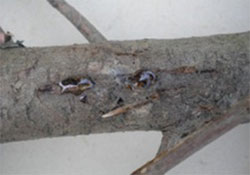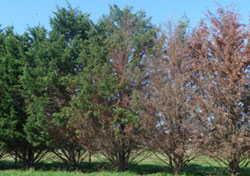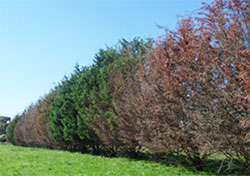Cypress canker and decline
Cypress canker is a significant disease that currently affects exotic conifers in Victoria. There is no proven cure for this disease.
‘Cypress decline’ is the now the preferred term for referring to cypress canker. It recognises causative factors in addition to the species of Seiridium fungi listed next.
Cause of cypress canker
Previously this disease was thought to be caused by a single Seiridium species, but scientists now believe that three 3 species (S.cardinale, S.cupressi and S.unicorne) can cause the same symptoms.
These fungi have been present in Victoria for more than 50 years.
Cypress decline in Victoria
A large number of dead and dying cypress trees have been observed in rural Victoria.
Our investigations in south and west Gippsland, the Mornington Peninsula and the Western District have found trees affected by various fungal pathogens, in particular cypress canker (Seiridium species), but also Botryosphaeria, Phomopsis and Pestalotiopsis species.
These fungi can all cause dieback symptoms, especially when environmental conditions have put trees under stress. They are a mixture of:
- primary pathogens (which can attack intact plants)
- secondary pathogens (which usually attack plants at sites where another infection already exists).
We believe that the last drought weakened the cypresses and left them vulnerable to infection.
Disease development has also been favoured by waterlogging or warm, humid conditions in some areas.
Symptoms of cypress canker
The following symptoms can indicate cypress canker:
- After the initial infection, the fungus kills the plant's vascular tissue, which causes characteristic sunken, lens-shaped cankers and ringbarking.
- This interferes with the vascular system of the tree and eventually causes death above the wound.
- Reddish cankers form at the infection site and resin often exudes from around the edges of the cankers or through cracks in the bark (Figure 1). Individual cankers can be elongated and there can be many along each infected branch.
- The spore-producing structures of the fungus can be identified on the surface of the bark as small, circular, black dots on the canker surface.
- Branches die rapidly, yellowing almost overnight as the foliage is starved of sap (Figures 2 and 3). If the infection is not managed, it can eventually lead to the death of the whole plant.
- A whole row of trees might not all be infected at once. Trees in a row may show symptoms at the same time or the disease may appear to move along the row (Figure 3).



Environmental conditions
Hot, humid weather, drought and insects such as bark beetles can speed up the decline of trees infected with cypress canker because of splitting bark and poor wound responses from the tree.
Spread of disease
Cypress canker infects a plant through spores (conidia), which are carried on the wind, in water droplets or by insects. Spores that land on healthy foliage can germinate under warm, moist conditions and infection occurs through natural fissures in the bark or through scars caused by mechanical damage (pruning, animals or falling branches).
The pathogen then girdles twigs, branches and the main trunk, interfering with the sap-conducting system and causing the foliage to die. Death may occur progressively from branch to branch.
New local infections can also develop when spores are washed down the tree or splashed from tree to tree by rain or overhead irrigation. They can also be transferred from plant to plant on pruning tools, or through the transport of infected cuttings or plants.
Species susceptibility
More than 25 conifer species can be affected by cypress canker, but susceptibility varies between the species.
Generally, older trees are more susceptible, but any tree is susceptible if in a stressed state (for example, through drought, waterlogging or poor nutrient status).
Susceptible species
- Cupressus macrocarpa (Monterey cypress) (susceptible under 10 years old)
- Chaemaecyparis lawsoniana various cultivars
- x Cupressocyparis leylandii 'Castlewellan Gold'
- x Cupressocyparis leylandii 'Leighton Green'
- x Cupressocyparis leylandii 'Naylors Blue'
- Cupressus sempervirens 'Swanes Golden' and other cultivars
- Cupressus torulosa
Less susceptible species
- Cupressus lusitanica (variable susceptibility)
- Cupressus arizonica (Arizona cypress)
- Calocedrus decurrens
- Thuja plicata (western red cedar)
- Thuja occidentalis
- Juniperus virginiana
Managing cypress canker
Management of cypress canker is the responsibility of the landowner or manager.
In significantly affected trees, the only long-term option might be to replace them with known tolerant cypress species or varieties.
Cypresses can also be replaced with unrelated plant species, such as Australian natives suitable for shelterbelts.
In re-planted or existing cypresses, canker damage can be minimised by ensuring trees are well sited and well managed. For example:
- Avoid planting susceptible species on disease-prone sites, such as those with high levels of nitrogen.
- Keep trees healthy to improve their natural defences against an initial infection. If fertilisers are required, they should be evenly distributed around the drip line of the trees. Watering may be needed during dry spells.
- Reduce the chances of branch or stem wounding (for example, by fencing off trees from livestock).
- Prune infected branches a minimum of 10 centimetres below the canker to help prevent infection spreading to the main stems (but take care not to over-prune). Pruning should preferably be done in winter or following dry weather, when spores are less likely to infect pruning wounds. After pruning, wound dressings may help to prevent spore infection. All pruning tools should be sterilised before and after use with either alcohol or dilute bleach.
- Remove and destroy severely diseased plants by deep burial or burning to help to reduce the risk of neighbouring trees becoming infected.
There are no fungicides registered for the control of cypress canker.
Movement of host plant material
Cypress canker is not a regulated disease in Victoria and there are no legal restrictions on the movement of host plant material. However, to minimise the risk of spreading the disease, don't move infected material from the property unless it's covered or in a sealed container.
Reporting an unusual plant insect pest or disease
Report any unusual plant pest or disease immediately using our online reporting form or by calling the Exotic Plant Pest Hotline on 1800 084 881. Early reporting increases the chance of effective control and eradication.
Please take multiple good quality photos of the pests or damage to include in your report where possible, as this is essential for rapid pest and disease diagnosis and response.
Your report will be responded to by an experienced staff member, who may seek more information about the detection and explain next steps.
Report onlinePhoto credits
Figure 1. Cypress cankers and resin on a Leyland cypress (Elizabeth Bush, Virginia Polytechnic Institute and State University, Bugwood.org)
References and more information
- Cunnington, J.H. (2007) Seiridium cupressi is the common cause of cypress canker in south-eastern Australia. Australasian Plant Disease Notes, 2, 5355
- Graniti A. (1998) Cypress canker: a pandemic in progress. Annual Review of Phytopathology 36, 91114. doi: 10.1146/annurev.phyto.36.1.91
- Reid, A. (2004) Cypress Canker (caused by Seiridium spp.) Department of Agriculture and food. Government of Western Australia. Note: 13
- Sydney Royal Botanic Gardens Trust Fact Sheet on Cypress Canker